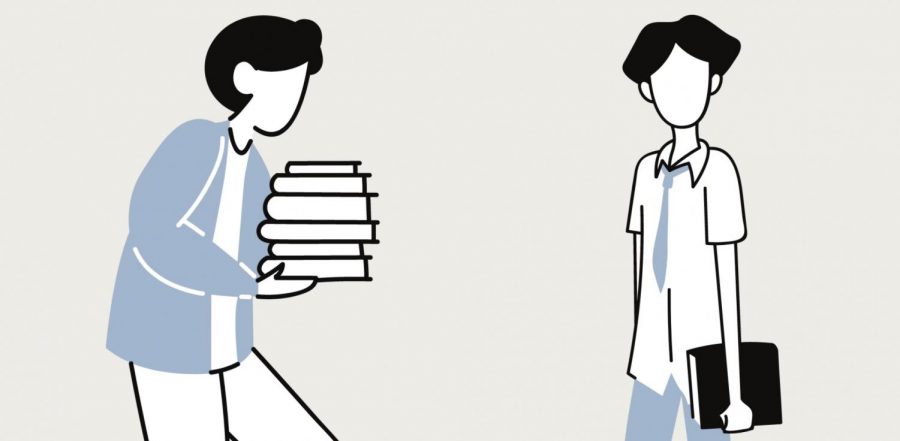Good Days, Bad Days, and Too Much Screen Time: How Educators at La Salle are Juggling Parenting and Teaching During The Pandemic
Teachers at La Salle have been grappling with the struggles of balancing parental responsibilities with instructing their own classes.
December 16, 2020
The transition into digital learning has affected everyone — especially parents, as they have had to create new normals for their children, while also dealing with the uncertainty of the pandemic.
The Falconer spoke to nine teachers to better understand how they’re balancing parenting and teaching during this chaotic time.
For Director of Service Ms. Sarah Maher, the pandemic has highlighted the different responsibilities men and women have as parents.
“There have been so many articles written about how this is hitting the working mom harder than the working dad,” Ms. Maher said.
While working remotely, Ms. Maher said the responsibility of caring for her children has fallen onto her. “I am finding myself in that situation of doing a million things at once, where my husband can simply go to a meeting,” she said.
It has become a normal occurrence for Ms. Maher’s three-year-old son, Liam, to loiter around her workspace during the day, as he knows his father, Daniel, cannot be bothered. “It becomes this cycle of Liam understanding that he can interrupt me, but not dad,” Ms. Maher said. “Liam is in every one of my Zoom calls, but he’s rarely seen in Daniel’s calls.”
When Ms. Maher speaks to other mothers in her community about her frustrations, they voice alike experiences. “Talking to my group of mom friends, it’s a very similar type of thing happening to women all over the world who are finding themselves in these roles where we’re juggling a lot more than our male counterparts seem to be,” Ms. Maher said.
Science teacher Ms. Amanda Schieber similarly described the transition to online school as “pretty difficult” because she suddenly had the responsibility of looking after her daughter during the school day while teaching her own class.“My husband started working from home when the pandemic started as well, so we could kind of trade off, but there’s definitely times when I’m trying to do something and she wants my attention and it’s difficult,” Ms. Schieber said.
A difficulty for Ms. Schieber has been having to balance her work schedule with her toddler’s needs. “I have my Zoom classes, that’s a priority and I have to do those, but a lot of times it’s her nap time to do grading and planning or I have to wait till she’s gone to bed, maybe that’s time that I’d like to be relaxing,” she said.
Alternatively, religious studies teacher Mr. Ryan Darmody has been able to parent his older child using a less hands-on approach during the pandemic. “My daughter is in sixth grade, 11 years old, she’s pretty self sufficient and pretty independent,” he said. “All we ask of her is that if she needs help, that she asks for help…We don’t expect her to get straight A’s, just that she does what her teachers assign her.”
English teacher Mr. Paul Dreisbach said that his eight-year-old daughter has found success with the online school model, benefitting from the shift in the fall that focused on assigning more synchronous work, which has given more structure to school days. However, Mr. Dreisbach’s children have struggled with the isolation aspect of quarantine.
Mr. Dreisbach has been working with his kids to manage their “flare ups.”
“Little moments where they are really frustrated, they’re sad, they’re feeling isolated, they’re bored,” Mr. Dreisbach said, “having to kind of explain to them, it’s not over yet, we know we still need to do this for our safety [and] for other people’s safety, it hasn’t been difficult from a practical standpoint, but it’s been really difficult emotionally.”
Like some other teachers and students, social studies teacher Mr. Alex Lanaghan has also preferred the structure of this fall’s online model. “I really like a synchronous schedule, it’s nice because it really forces everybody into certain timeframes,” he said.
The initial chaos of the spring has significantly calmed down for Mr. Lanaghan’s family, but “it’s still pretty busy around here,” he said. “There’s five of us, we’re all on Zoom. It’s a small house [and] we all have different kinds of nooks and crannies that we take over during the day.”
Speaking in retrospect, Mr. Lanaghan remarked on how becoming a parent has shifted his perspective as an educator. “I think becoming a parent 10 years ago shifted my perspective on being a teacher, and then now that my kids are in school, and I see firsthand what it’s like for them to be in school on Zoom,” Mr. Lanaghan said.
Football coach and health teacher Mr. Chris Sulages has been supporting his daughter through the pandemic by mandating movement and exercise. “There are good days and bad days,” he said. “I’m a health and P.E. teacher so we try to go for a walk every day. We have a basketball hoop in my house. We try to do all kinds of different stuff that gets her energy out but also engages the outside and fresh air.”
Similarly, Director of Community Ms. Liz Banta and her two children have incorporated physical activity into their daily routine. “We are lucky we have a nice big yard so they get to play outside a lot, but they’re definitely having way more screen time than I would like,” Ms. Banta said. “They’re on their iPads or watching TV.”
Mr. Darmody also expressed concern regarding the amount of time his son spends on electronic devices as part of the transition to online school. “He doesn’t get recess with his friends, he doesn’t get lunch [with his friends], ” Mr. Darmody said. “He wants to play games, he wants to play Minecraft, or he wants to watch Disney+ and I really don’t want to do more screen time, but then it gets cold outside, it’s harder to do outdoor activities and stuff like that.”
Similar to Mr. Sulages and other educators, theater teacher Mr. Michael Shelton has also felt the “good days and bad days” of parenting during the pandemic.
Mr. Shelton is the father of four children, who are ages two, three, six, and eight. “It’s a really interesting dynamic in our house on the days when I am working from home because our eight year old is doing her second grade, our six year old is doing his kindergarten, I’m doing teaching and it’s like we’re in three different rooms, all in front of our little iPads,” Mr. Shelton said. “We’re just trying to be supportive of our kids with their personalities.”
For Mr. Shelton’s family, cultivating a consistent routine has been a key factor in adjusting to the new normal. “It’s been helpful to have a set schedule — we always get up at this time, and we have breakfast at this time, and you log in at this time, we take a break,” he said. “It really helps them kind of get into a rhythm that at least feels normal under the circumstances.”
The transition to online school was not as difficult for science teacher Mr. Kyle Voge, as he said he felt La Salle was ahead of the curve technology-wise. “I was pretty comfortable with my tech skills and so moving to online only was not too tough,” he said. “It wasn’t fun, I definitely didn’t like it. The fun of teaching is interacting with the students, so that part definitely went downhill.”
To keep their children occupied during the day, Mr. Voge and his wife, Sarah, use dry erase boards to give their children a checklist to complete throughout the day. Once the children complete their checklist, they are allotted recreational screen time before dinner.
“The thing that I’m most grateful for in terms of keeping my sanity is that my kids are good kids and they listen,” Mr. Voge said. “I haven’t had to deal with any attitude or behavior problems with them, they’ve been sweet kids and I’m very lucky for that.”





